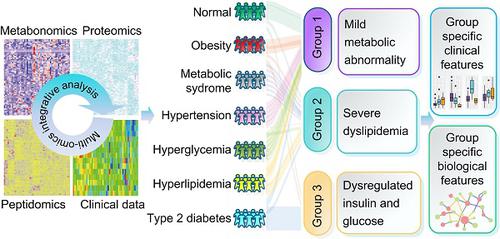Theranostics ( IF 12.4 ) Pub Date : 2020-01-01 , DOI: 10.7150/thno.41106 Di Chen 1 , Xinjie Zhao 1 , Zhigang Sui 1 , Huan Niu 2, 3 , Luonan Chen 4 , Cheng Hu 5 , Qiuhui Xuan 1 , Xuhong Hou 5 , Rong Zhang 5 , Lina Zhou 1 , Yanli Li 1 , Huiming Yuan 1 , Yukui Zhang 1 , Jiarui Wu 4 , Lihua Zhang 1 , Ren'an Wu 2 , Hai-Long Piao 1 , Guowang Xu 1 , Weiping Jia 5

|
Metabolic syndrome (MTS) is a cluster of concurrent metabolic abnormal conditions. MTS and its component metabolic diseases are heterogeneous and closely related, making their relationships complicated, thus hindering precision treatment.
Methods: We collected seven groups of samples (group a: healthy individuals; group b: obesity; group c: MTS; group d: hyperglycemia, group e: hypertension, group f: hyperlipidemia; group g: type II diabetes, n=7 for each group). We examined the molecular characteristics of each sample by metabolomic, proteomic and peptidomic profiling analysis. The differential molecules (including metabolites, proteins and peptides) between each disease group and the healthy group were recognized by statistical analyses. Furthermore, a two-step clustering workflow which combines multi-omics and clinical information was used to redefine molecularly and clinically differential groups. Meanwhile, molecular, clinical, network and pathway based analyses were used to identify the group-specific biological features.
Results: Both shared and disease-specific molecular profiles among the six types of diseases were identified. Meanwhile, the patients were stratified into three distinct groups which were different from original disease definitions but presented significant differences in glucose and lipid metabolism (Group 1: relatively favorable metabolic conditions; Group 2: severe dyslipidemia; Group 3: dysregulated insulin and glucose). Group specific biological signatures were also systematically described. The dyslipidemia group showed higher levels in multiple lipid metabolites like phosphatidylserine and phosphatidylcholine, and showed significant up-regulations in lipid and amino acid metabolism pathways. The glucose dysregulated group showed higher levels in many polypeptides from proteins contributing to immune response. The another group, with better glucose/lipid metabolism ability, showed higher levels in lipid regulating enzymes like the lecithin cholesterol acyltransferase and proteins involved in complement and coagulation cascades.
Conclusions: This multi-omics based study provides a general view of the complex relationships and an alternative classification for various metabolic diseases where the cross-talk or compensatory mechanism between the immune and metabolism systems plays a critical role.
中文翻译:

对六种代谢综合征相关疾病的分子特征和分类进行多组学研究。
代谢综合征(MTS)是一系列并发的代谢异常情况。MTS及其组成代谢性疾病是异质性的,并且密切相关,使它们的关系复杂化,从而妨碍了精确治疗。
方法:我们收集了七组样本(a组:健康个体; b组:肥胖症; c组:MTS; d组:高血糖症,e组:高血压,f组:高脂血症; g组:II型糖尿病,n = 7每个组)。我们通过代谢组学,蛋白质组学和肽组分析来检查每个样品的分子特征。通过统计分析可以识别每个疾病组与健康组之间的差异分子(包括代谢产物,蛋白质和多肽)。此外,结合了多组学和临床信息的两步聚类工作流程用于重新定义分子和临床差异组。同时,基于分子,临床,网络和途径的分析被用于鉴定特定组的生物学特征。
结果:确定了六种疾病中共有的和特定于疾病的分子概况。同时,将患者分为三个不同的组,这三个组与原始疾病定义不同,但在葡萄糖和脂质代谢方面存在显着差异(第1组:相对有利的代谢条件;第2组:严重血脂异常;第3组:胰岛素和葡萄糖失调)。还系统地描述了组特异性的生物特征。血脂异常组在多种脂质代谢产物如磷脂酰丝氨酸和磷脂酰胆碱中的含量较高,并且在脂质和氨基酸代谢途径中显示出明显的上调。葡萄糖失调组在有助于免疫应答的蛋白质的许多多肽中显示出较高的水平。另一组
结论:这项基于多组学的研究为各种代谢性疾病的复杂关系提供了一般视图,并为免疫系统和代谢系统之间的串扰或补偿机制发挥了关键作用的各种代谢疾病提供了替代分类。



























 京公网安备 11010802027423号
京公网安备 11010802027423号